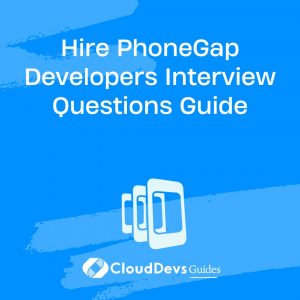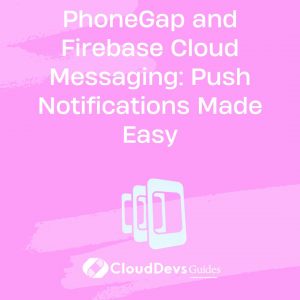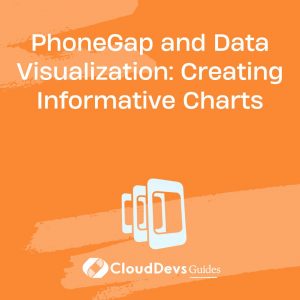Hire PhoneGap Developers Interview Questions Guide
PhoneGap, a widely used mobile app development framework, allows developers to create cross-platform applications using web technologies. When looking to hire skilled PhoneGap developers, it’s crucial to evaluate their expertise in mobile app development, JavaScript, and PhoneGap-specific functionalities. This guide will assist you in navigating the hiring process effectively, enabling you to identify candidates with the right skills for your mobile app projects.
Table of Contents
1. Reasons to Hire PhoneGap Developers
Embarking on the journey to hire PhoneGap developers? Here are the key reasons to consider:
1.1 Cross-Platform Development
PhoneGap enables the development of cross-platform mobile applications, saving time and resources by allowing developers to write code once and deploy it on multiple platforms.
1.2 Web Technology Stack
Leverage web technologies like HTML, CSS, and JavaScript to build mobile apps, making it accessible for developers with web development experience.
1.3 Native-Like Performance
PhoneGap applications offer a native-like user experience by utilizing device APIs, ensuring high performance and responsiveness.
2. How to Hire PhoneGap Developers
Follow these steps for a successful journey in hiring PhoneGap developers:
2.1 Job Requirements
Define specific job prerequisites, outlining the skills and experience you’re seeking, including proficiency in PhoneGap, JavaScript, HTML, and CSS.
2.2 Search Channels
Utilize CloudDevs’ expertise in connecting you with potential candidates. Leverage job postings, online platforms, and tech communities to discover talented PhoneGap developers.
2.3 Screening
Scrutinize candidates’ PhoneGap proficiency, mobile app development experience, and additional skills.
2.4 Technical Assessment
Develop a comprehensive technical assessment, including coding challenges and real-world scenarios related to PhoneGap development.
3. Core Skills of PhoneGap Developers to Look For
When evaluating PhoneGap developers, focus on these core skills:
- PhoneGap/Cordova: Proficiency in using PhoneGap/Cordova for cross-platform mobile app development.
- JavaScript: Strong understanding of JavaScript, especially asynchronous programming and DOM manipulation.
- Mobile App Design: Knowledge of mobile app design principles and user interface (UI) best practices.
- API Integration: Experience integrating with RESTful APIs and third-party services.
- Testing and Debugging: Ability to write unit tests and debug mobile applications effectively.
4. Overview of the PhoneGap Developer Hiring Process
Here’s an overview of the PhoneGap developer hiring process:
4.1 Defining Job Requirements and Skillsets
Lay the foundation by outlining clear job prerequisites, specifying the skills and knowledge you’re seeking in PhoneGap developers.
4.2 Crafting Compelling Job Descriptions
Create engaging job descriptions that accurately convey the role, emphasizing the PhoneGap-specific skills required.
4.3 Crafting PhoneGap Developer Interview Questions
Develop a comprehensive set of interview questions covering PhoneGap intricacies, mobile app development, and relevant technologies.
5. Sample PhoneGap Developer Interview Questions and Answers
Explore these sample questions with detailed answers to assess candidates’ PhoneGap skills:
Q1. Explain the structure of a PhoneGap project and its main components.
A:
<!-- Sample Answer: Structure of a PhoneGap project --> /project-root /www index.html /css styles.css /js app.js /img logo.png config.xml
Q2. How does PhoneGap handle device-specific features and APIs?
A:
PhoneGap uses plugins to access device-specific features and APIs. For example, to access the camera, you might use the Camera plugin:
// Sample Answer: Using Camera plugin
navigator.camera.getPicture(onSuccess, onFail, { quality: 50 });
function onSuccess(imageData) {
console.log('Image URI: ' + imageData);
}
function onFail(message) {
console.log('Failed because: ' + message);
}
Q3. Implement a PhoneGap application that makes a REST API call to retrieve data and display it on the screen.
A:
// Sample Answer: Making a REST API call in PhoneGap
fetch('https://api.example.com/data')
.then(response => response.json())
.then(data => {
document.getElementById('result').innerText = JSON.stringify(data);
})
.catch(error => console.error('Error:', error));
Q4. What are the key differences between PhoneGap and Cordova?
A:
PhoneGap and Cordova are essentially the same. Adobe PhoneGap is built on the open-source Apache Cordova project. PhoneGap includes additional tools and services, but the core of both is the same.
Q5. Explain the purpose of the config.xml file in a PhoneGap project.
A:
The config.xml file in a PhoneGap project is a configuration file that contains settings for the app, such as the app’s name, description, version, and permissions. It also defines preferences, plugins, and icons used by the app.
Q6. How does PhoneGap handle offline storage in mobile applications?
A:
PhoneGap provides the Web Storage API (localStorage and sessionStorage) for client-side storage. Additionally, developers can use plugins like Cordova SQLite for more advanced offline storage capabilities, allowing the app to store data in a local database.
Q7. Create a simple PhoneGap plugin that displays a native toast notification.
A:
// Sample Answer: PhoneGap plugin for toast notification
var ToastPlugin = {
showToast: function (message, duration, successCallback, errorCallback) {
cordova.exec(successCallback, errorCallback, 'ToastPlugin', 'showToast', [message, duration]);
}
};
Q8. How does PhoneGap handle responsiveness and adapt to different device screen sizes?
A:
PhoneGap leverages responsive design principles using CSS media queries to adapt the layout and styles based on the device’s screen size. Developers can create a flexible and responsive UI that adjusts seamlessly across various devices.
Q9. Explain the purpose of the PhoneGap Build service.
A:
PhoneGap Build is a cloud service that allows developers to build PhoneGap apps in the cloud without the need to install SDKs locally. It simplifies the build process, making it easier to compile apps for multiple platforms.
Q10. Write a PhoneGap application that uses the device accelerometer to detect motion.
A:
// Sample Answer: PhoneGap application using accelerometer
document.addEventListener('deviceready', onDeviceReady, false);
function onDeviceReady() {
navigator.accelerometer.watchAcceleration(onSuccess, onError, { frequency: 1000 });
}
function onSuccess(acceleration) {
console.log('Acceleration X: ' + acceleration.x +
' Y: ' + acceleration.y +
' Z: ' + acceleration.z);
}
function onError() {
console.error('Accelerometer error.');
}
6. Hiring PhoneGap Developers through CloudDevs
Step 1: Connect with CloudDevs
Initiate a conversation with a CloudDevs consultant to discuss your project requirements, preferred skills, and expected experience.
Step 2: Discover Your Ideal Match
Within a short timeframe, CloudDevs presents you with carefully selected PhoneGap developers from their pool of pre-vetted professionals. Review their profiles and select the candidate who aligns with your project’s vision.
Step 3: Embark on a Risk-Free Trial
Engage in discussions with your chosen developer to ensure a smooth onboarding process. Once satisfied, formalize the collaboration and commence a week-long free trial.
By leveraging the expertise of CloudDevs, you can effortlessly identify and hire exceptional PhoneGap developers, ensuring your team possesses the skills required to build remarkable mobile applications.
7. Conclusion
With these additional technical questions and insights at your disposal, you’re now well-prepared to assess PhoneGap developers comprehensively. Whether you’re developing mobile apps for iOS, Android, or other platforms, securing the right PhoneGap developers for your team is pivotal to the success of your projects.
Table of Contents







